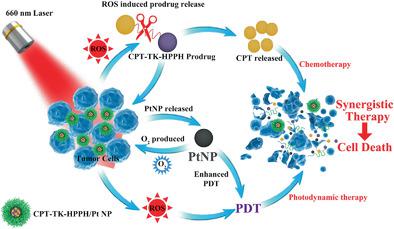Our official English website, www.x-mol.net, welcomes your
feedback! (Note: you will need to create a separate account there.)
Polymeric Nanoparticles with ROS‐Responsive Prodrug and Platinum Nanozyme for Enhanced Chemophotodynamic Therapy of Colon Cancer
Advanced Science ( IF 14.3 ) Pub Date : 2020-09-06 , DOI: 10.1002/advs.202001853 Ying Hao 1 , Yuwen Chen 1 , Xinlong He 1 , Yongyang Yu 2 , Ruxia Han 1 , Yang Li 1 , Chengli Yang 1 , Danrong Hu 1 , Zhiyong Qian 1
Advanced Science ( IF 14.3 ) Pub Date : 2020-09-06 , DOI: 10.1002/advs.202001853 Ying Hao 1 , Yuwen Chen 1 , Xinlong He 1 , Yongyang Yu 2 , Ruxia Han 1 , Yang Li 1 , Chengli Yang 1 , Danrong Hu 1 , Zhiyong Qian 1
Affiliation

|
The combination of chemotherapy and photodynamic therapy (PDT) has promising potential in the synergistic treatment of cancer. However, chemotherapy and photodynamic synergistic therapy are impeded by uncontrolled chemotherapeutics release behavior, targeting deficiencies, and hypoxia‐associated poor PDT efficacy in solid tumors. Here, a platinum nanozyme (PtNP) loaded reactive oxygen species (ROS)‐responsive prodrug nanoparticle (CPT‐TK‐HPPH/Pt NP) is created to overcome these limitations. The ROS‐responsive prodrug consists of a thioketal bond linked with camptothecin (CPT) and photosensitizer‐2‐(1‐hexyloxyethyl)‐2‐devinyl pyropheophorbide‐a (HPPH). The PtNP in CPT‐TK‐HPPH/Pt NP can efficiently catalyze the decomposition of hydrogen peroxide (H2O2) into oxygen to relieve hypoxia. The production of oxygen can satisfy the consumption of HPPH under 660 nm laser irradiation to attain the on‐demand release of CPT and ensure enhanced photodynamic therapy. As a tumor diagnosis agent, the results of photoacoustic imaging and fluorescence imaging for CPT‐TK‐HPPH/Pt NP exhibit desirable long circulation and enhanced in vivo targeting. CPT‐TK‐HPPH/Pt NPs effectively inhibit tumor proliferation and growth in vitro and in vivo. CPT‐TK‐HPPH/Pt NP, with its excellent ROS‐responsive drug release behavior and enhanced PDT efficiency can serve as a new cancer theranostic agent, and will further promote the research of chemophotodynamic synergistic cancer therapy.
中文翻译:

具有 ROS 响应性前药和铂纳米酶的聚合物纳米颗粒用于增强结肠癌的化学光动力治疗
化疗和光动力疗法(PDT)的结合在癌症的协同治疗中具有广阔的前景。然而,化疗和光动力协同治疗受到实体瘤中不受控制的化疗药物释放行为、靶向缺陷以及缺氧相关的 PDT 疗效不佳的阻碍。在这里,创建了一种负载活性氧(ROS)的铂纳米酶(PtNP)响应性前药纳米颗粒(CPT-TK-HPPH/Pt NP)来克服这些限制。 ROS响应性前药由与喜树碱(CPT)和光敏剂-2-(1-己氧基乙基)-2-乙烯基焦脱镁叶绿酸-a(HPPH)连接的硫缩酮键组成。 CPT-TK-HPPH/Pt NP中的PtNP可以有效催化过氧化氢(H 2 O 2 )分解为氧气以缓解缺氧。氧气的产生可以满足660 nm激光照射下HPPH的消耗,实现CPT的按需释放,保证增强光动力治疗。作为肿瘤诊断剂,CPT-TK-HPPH/Pt NP 的光声成像和荧光成像结果显示出理想的长循环和增强的体内靶向性。 CPT-TK-HPPH/Pt NPs 在体外和体内有效抑制肿瘤增殖和生长。 CPT-TK-HPPH/Pt NP以其优异的ROS响应性药物释放行为和增强的PDT效率可以作为一种新型的癌症治疗诊断剂,并将进一步推动化学光动力协同癌症治疗的研究。
更新日期:2020-10-22
中文翻译:

具有 ROS 响应性前药和铂纳米酶的聚合物纳米颗粒用于增强结肠癌的化学光动力治疗
化疗和光动力疗法(PDT)的结合在癌症的协同治疗中具有广阔的前景。然而,化疗和光动力协同治疗受到实体瘤中不受控制的化疗药物释放行为、靶向缺陷以及缺氧相关的 PDT 疗效不佳的阻碍。在这里,创建了一种负载活性氧(ROS)的铂纳米酶(PtNP)响应性前药纳米颗粒(CPT-TK-HPPH/Pt NP)来克服这些限制。 ROS响应性前药由与喜树碱(CPT)和光敏剂-2-(1-己氧基乙基)-2-乙烯基焦脱镁叶绿酸-a(HPPH)连接的硫缩酮键组成。 CPT-TK-HPPH/Pt NP中的PtNP可以有效催化过氧化氢(H 2 O 2 )分解为氧气以缓解缺氧。氧气的产生可以满足660 nm激光照射下HPPH的消耗,实现CPT的按需释放,保证增强光动力治疗。作为肿瘤诊断剂,CPT-TK-HPPH/Pt NP 的光声成像和荧光成像结果显示出理想的长循环和增强的体内靶向性。 CPT-TK-HPPH/Pt NPs 在体外和体内有效抑制肿瘤增殖和生长。 CPT-TK-HPPH/Pt NP以其优异的ROS响应性药物释放行为和增强的PDT效率可以作为一种新型的癌症治疗诊断剂,并将进一步推动化学光动力协同癌症治疗的研究。











































 京公网安备 11010802027423号
京公网安备 11010802027423号